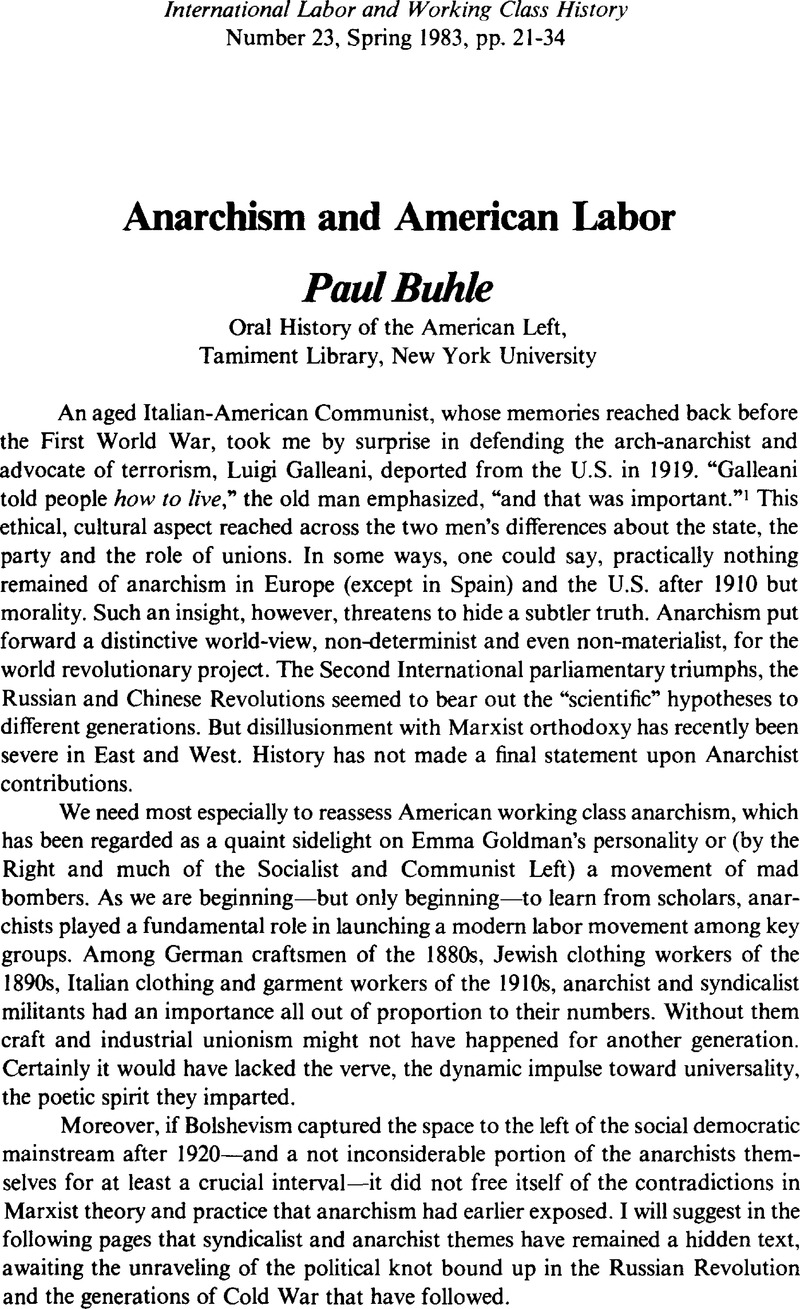Article contents
Anarchism and American Labor
Published online by Cambridge University Press: 16 December 2008
Abstract

- Type
- Essays
- Information
- Copyright
- Copyright © International Labor and Working-Class History, Inc. 1983
References
NOTES
1. Tape with Luigi Nardella. Cranston, R.I., 1977. Archives of the Oral History of the American Left, Tamiment Library, NYU.Google Scholar
2. Fire in the Eyes of Men (New York, 1980).Google Scholar
3. Nationalism and Culture. 1978Google Scholar Edition, published by Michael E. Coughlin, 1985 Selby Ave., St. Paul, MN, 55104.
4. For instance, Rivkin, B., Grunt-Tendentsen fun der Yidisher Literatur in Amerika (New York, 1948).Google Scholar
5. Stekloff, G.M., History of the First International, tr. Eden, and Paul, Cedar (London, 1928).Google Scholar
6. The Voice of Terror: A Biography of Johann Most (Westport, 1980).Google Scholar
7. Rocker, Rudolf, Johann Most: Das Leben eines Rebellen (Berlin, 1924).Google Scholar
8. See, e.g., Nelson, Bruce C., “Counting Anarchists,” Chicago Project Conference, Chicago, 1981Google Scholar, to be published in a book of collected essays, edited by Hartmut Keil and John Jentz.
9. See, e.g., my essay, “Knights and Socialists,” from the Knights of Labor Symposium. 1981, to be published in a book edited by Jonathon Garlock.
10. One of the most interesting memoirs about this period is Rocker's, RudolfIn Shturem. tr. Birnboim, I. (Buenos Aires, 1952).Google Scholar
11. Fishman, William J., Jewish Radicals: From Czarist Shtetl to London Ghetto (N.Y., 1974).Google Scholar
12. For Yiddish readers, there are substantial, hardly-used sources: Bialosotzki, B.I., ed., Dud Edelshtot Gedenk-Bukh (Los Angeles, 1952)Google Scholar, a large compendium about the great poet of the early movement: Joseph Cohen's autobiography, Di Yidishe Anarkhistishe Bevegung in Amerika (Philadelphia, 1945)Google Scholar, now being translated by Dolgoff, Esther; Sh. Yanofsky's autobiography, Ershte Yorn fun Yidishe Frayhaytlekhn Sotsianism (New York, 1948)Google Scholar; and Gordin, Aba, Sh. Yanofsky, Zayn Leben, Zayn Shafn (Los Angeles, 1957).Google Scholar
13. “The Origins of Nationalism in the Proletariat,” in Pannekoek and Gorter's Marxism, ed. and introduced by Smart, D.A. (London, 1978), 90–91.Google Scholar
14. Sources here remain especially scanty, outside the primary and still scarcely used ones: Galleani's Cronoca Soversivva, Giovannitti's Il Proletario, Tresca's Il Martello, among others, all available at the Immigration History Research Center, St. Paul, Minnesota. Occasional essays have been published in La Parola del Popolo, last of the inheritors to the Italian immigrant radicalism. See my preliminary effort, “Italian-American Radicals and the Labor Movement, 1905–1930,” Radical History Review, 17 (1978).Google Scholar
15. The former translated by Lorraine and Fredy Perlman, the latter by Holly Cantine and Fredy Perlman, both published by the Perlmans' press, Detroit: Black and Red. 1974. Available from Box 9546, Detroit, MI 48202. And see the earlier work in ILWCH: Martin Miller's fine essay. “Anarchism vs. Marxism in the Russian Revolution, A Review of Recent Literature,” ILWCH, 9 (05, 1976), 28–37.Google Scholar
16. Ahrne Thorne, the final editor ofthe Freie Arbeter Shtimme, made this point to me.
17. A single vivid text by a foremost ideologist of Liberation Theology: Miranda's, JoseCommunism in the Bible, tr. Barr, Robert R. (Maryknoll, 1982).Google Scholar
18. Wolfe, Bertram D., A Life in Two Centuries (Briarcliff Manor, N.Y., 1981)Google Scholar; Alexander, Robert J., The Right Opposition (Westport, 1981).Google Scholar
19. My comment on Yiddish communists in “Jews and American Communism: The Cultural Question.” Radical History Review, 23 (1981)Google Scholar. Unfortunately, outside some work done on California, little study has been given to the early Communist movement's local activities; periodicals like the Truth, edited by a former Christian Socialist minister, remain virtually unexplored.
20. Workers Age (New York), 03 26, 1938.Google Scholar
21. CLR James has repeatedly insisted that his own perspective, breaking free of all van guard conceptions to release the spontaneous capacity of the working class, cannot recapitulate anarchism or syndicalism because these formations represented an earlier stage of production. This is a point well-taken, and not explored here; but I am convinced that the post-vanguard view actually reiterates key insights of anarchism and syndicalism at a higher level. See my essay on James, , “Marxism in the U.S.A.,” in CLR James: His Life and Work, published as Urgent Tasks, 12 (1981).Google Scholar
22. See Cardenal, , ed., The Gospel in Solentiname, III tr. Walsh, Donald (Maryknoll, 1979)Google Scholar; or his Homage to the American Indians, tr. Monique & Carlos Altshul (Baltimore. 1973).Google Scholar
- 1
- Cited by


